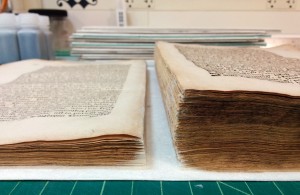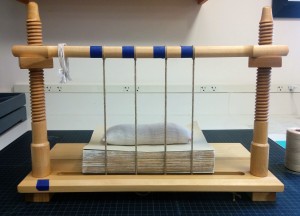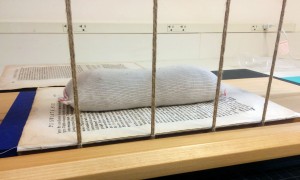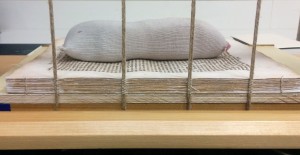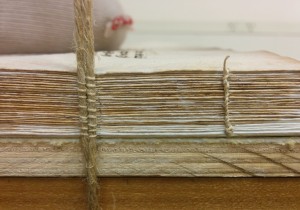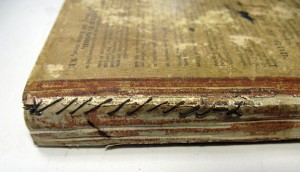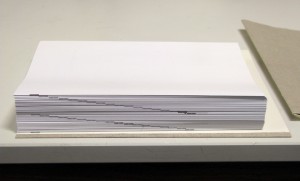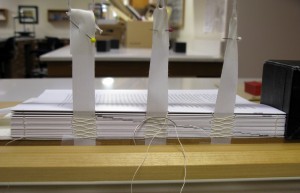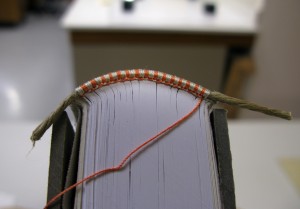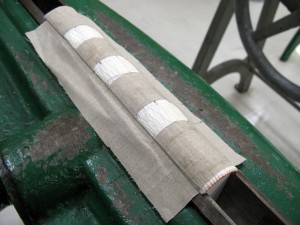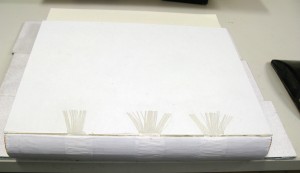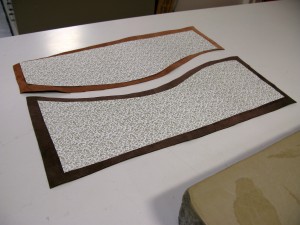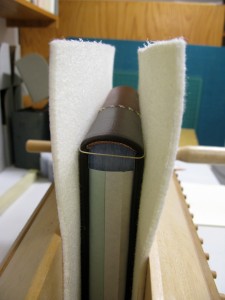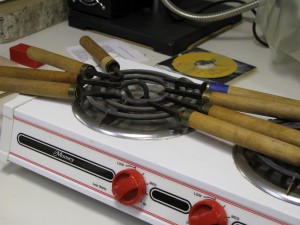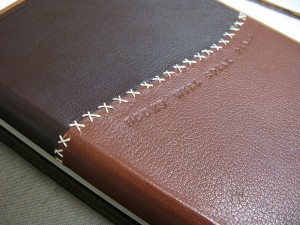In the Thick of It: Part 2 in a series on the treatment of Summerfield D544
August 15th, 2016Back in February, I wrote about undertaking the treatment of the 1683 volume Kazania na niedziele calego roku [Sermons for Sundays of the Whole Year] by Pawel Kaczyński (call number: Summerfield D544). At the time of that writing, I’d gotten as far as disbinding, cleaning, and mending the folios before it was necessary to put the treatment aside for a while to focus on other things. This summer I’ve brought the book out again to tackle the next phase of its treatment, preparation for rebinding.
I had already mended most of the folios along the inner spine folds, but they still needed reinforcement, or guarding, along the outer spine folds in order to be strong enough for sewing. Because there are exactly 100 single-folio sections in this volume, I chose a tissue for the guards that was as thin as possible to minimize added bulk while also providing the needed strength to the folds.
Guarding of folios in progress. Note the smooth spine folds on the guarded folios, left, and the more ragged edges of the unguarded folios on the right. Click image to enlarge.
The text block with guarding completed.
The amount of damage to this volume was so significant that for the sake of efficiency it was necessary to keep the mending fairly minimal, adding stabilizing mends with very thin tissue where it was most needed, rather than filling in every loss with color-matched tissue. However, there was a very large loss to the lower portion of the title page, so I chose to fill in that area; the page was physically stable, but a fill greatly improves it aesthetically. I selected a Japanese paper of about the same weight as the text paper and toned it with diluted watercolors to achieve a color that is sympathetic to the color of the text paper.
Title page of Summerfield D544 with toned Japanese paper compensation along lower edge.
With the mending and guarding completed, the next step is sewing. The text block was originally sewn two-on, which means that two gatherings are sewn on at once with a single pass of thread, rather than sewing the gatherings one at a time. This method of sewing reduces the swell of the spine that occurs when thread is introduced; with 100 gatherings in this text block, it makes sense that the original binder chose to sew it this way, and I decided to re-sew it in the same manner. To further reduce bulking (in addition to sewing two-on), I chose a thinner thread than I’d normally use. The last step before sewing was to select endpapers for the volume; I opted for Nideggen, a paper whose tan color and subtle texture go very well with that particular warm, grimy tone of old paper. Once the endpapers were cut, I lined up the text block on the sewing frame to mark the positions of the cords, strung the cords onto the frame, and at long last, started sewing.
Stringing up the cords on the sewing frame.
Beginning to sew – three sections down and only 97 to go!
About one-quarter of the way through sewing.
Detail of double cords and kettle stitch at tail end of text block.
Sewing multiple gatherings at a time can be a little awkward at the outset, but now that I’ve found a rhythm to it, the sewing is progressing at a nice pace. Soon all that will be left to do will be to put the book into a new paper case. I look forward to presenting the finished volume in one last installment of this series later this fall!
Angela Andres
Special Collections Conservator
Conservation Services

